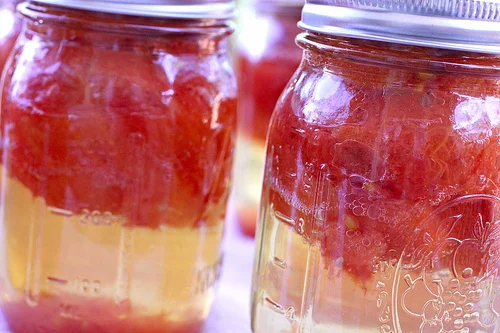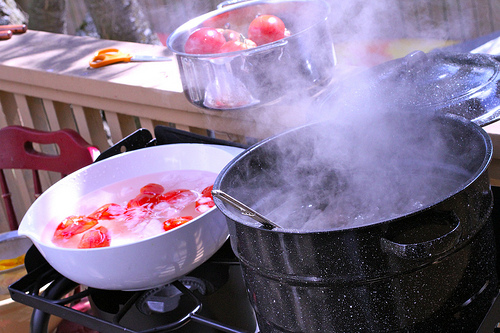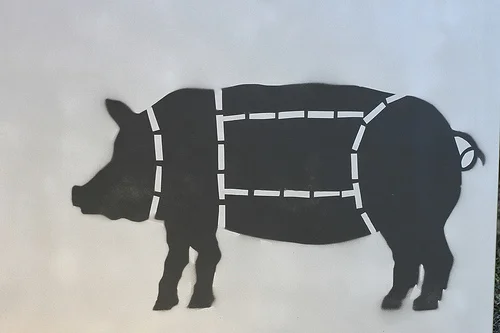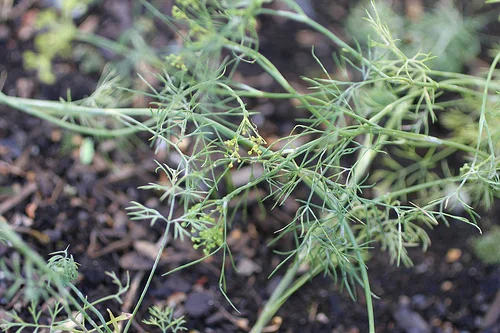people don't have to die: canning tomatoes safely
I can do this. I probably won't kill my family. Nobody will die... right?
Canning is scary to a lot of people---and it is wise to proceed with caution. The important thing is to educate yourself about the process, and to follow recipes and instructions from trusted sources (curious why the tomatoes and water separated? more on that later). I needed to understand the ins and outs of canning, because I knew canning was a farmstead endeavor that I could not resist: jarring just-picked berries and making killer peach plum ginger sauce would be part of my repertoire forever.
I find myself plunging into bulk buys---buying food directly from farmers---so I can have boxes of cucumbers and plums, tomatoes and strawberries to 'put up.' I cannot help myself: once curious about something I have to go 'all in' and master it; I took a class to receive my Master in Preservation Certificate.
A big reason: so I would understand the process, and be able to share safe canning practices with all of you. To be a go-to, trusted source for home preservation.
And so I could can tomatoes, safely.
You can 'can' tomatoes in a boiling water bath and/or a pressure canner. I like to use the pressure canner because it 'cooks' the tomatoes for less time and at a higher temperature. Note: some recipes for tomato sauces, chutneys or salsa may require a pressure canner for processing due to too many low acid ingredients. There is safety in high acid foods---they are not an environs for bacteria and/or botulism. (Many fruits have high acidity, which is why canning jams and jellies is a great place to start!).
I always put a tiny bit of citric acid into each jar of straight tomatoes, tomato sauce, crushed tomatoes and tomato juice. This is because there are thousands of varieties of tomatoes all with a different acid content. Some tomatoes are low in acid and others are high. A tiny bit of citric acid ensures the safety of the product. Instead of citric acid (which you can buy bulk at Whole Foods, PCC etc.) you may use bottled lemon juice.
1 Tablespoons bottled lemon juice OR 1/4 tsp citric acid per PINT of tomatoes
2 Tablespoons bottled lemon juice OR 1/2 tsp citric acid per QUART of tomatoes
Note: I use citric acid for 'safety insurance'; in addition to the citric acid you may add any amount of lemon juice, sugar and/or a pinch of salt safely to each jar.
Canning Tomatoes:
- Wash and sanitize jars, lids and rings; they should be HOT when you fill them with tomatoes. You know the drill: no chips on the rim, new lids every time, a sanitized surface and tools.
- Remove tomato skins: boil a pot of water and fill a large bowl with ice and water. Grab a strainer, tongs or slotted spoon to extract tomatoes from hot boiling water. Drop tomatoes in boiling water until skins crack (30 seconds or so), remove and place in ice bath (another 30 seconds or so); remove skins and cores.
- Process tomatoes according to instructions (for crushed you immediately place them into a pan and cook; for whole you put them into hot jars with boiling water or boiling tomato juice).
- Put tomatoes in hot jars---leaving 1/2 inch headspace---and wipe rims (I dip paper towels in clean boiling water to wipe rims). Remove air bubbles (chopsticks are great for this). Put on lids and rings and process in pressure canner OR hot water bath according to times/altitude etc.
- When finished processing, off heat or move pot and let jars sit 5 more minutes in hot water; remove to a towel-lined counter to cool undisturbed for 24 hours. They are sealed properly if the lids are 'suctioned' and you cannot compress lid with finger (there should be no 'give'). You should also be able to: remove ring(s) and hold up jar(s) by the lid alone.
Hot Water Bath Canning Altitude Adjustments*:
- from 0 - 1000 feet above sea level, follow recipe
- from 1000 - 3000 feet add 5 minutes to processing time
- from 3001 - 6000 feet add 10 minutes to processing time
- from 6001 or more feet add 15 minutes to processing time
Dial Gauge Pressure Canning Altitude Adjustments:
- from 0 - 2000 feet, process tomatoes at 11 LBS of pressure
- from 2001 - 4000 feet, process tomatoes at 12 LBS of pressure
- from 4001 - 6000 feet, process tomatoes at 13 LBS of pressure
- from 6001 - 8000 feet, process tomatoes at 14 LBS of pressure
- above 8000 feet it will explode. Just kidding.
Weighted Gauge Pressure Canning Altitude Adjustment:
- at ALL altitudes above 1000 feet, food must be processed at 15 LBS of pressure
Canning: Crushed Tomatoes
Note: this is a hot pack recipe.
Blanch tomatoes to remove skins and cores. Put immediately into large pot, crushing them a bit and stirring. Keep adding tomatoes and bring to boil [gently] for 5 full minutes. During those 5 minutes: get out the hot jars, add citric acid and lemon juice/salt/sugar if using. Fill jars with hot tomatoes, leave 1/2 inch headspace, remove bubbles, wipe rims, add lids and rings and place in hot water bath or pressure canner. Process (make altitude adjustments if needed, see above):
- Hot water bath PINTS for 35 minutes
- Hot water bath QUARTS for 45 minutes
- Dial Pressure Canner 11 LBS for 15 minutes
- Weighted Pressure Canner 10 LBS for 15 minutes
General Tips for Canning [Tomatoes]:
- I bought industrial rubber gloves at Home Depot, and use them to hold the hot jars when putting on lids and taking them out of the water.
- Don't over-tighten rings on the jars. You should twist on the rings so they are just finger-tight, not so tight or your jar might break---the air does actually sneak out of the top of the jars while being processed. This is a good thing. And yes: I have tightened the lids too much and had jars break inside the hot water bath. Almost funny, but not quite.
- When in doubt: have an extra pot of boiling water. I often have an extra pot of boiling water or even boiling water in my tea kettle. Why? To use to heat lids, sanitize tools, add to the pressure canner and/or to top off the hot water bath (as water condensates, I add extra water to keep at least 1 inch boiling water above jars).
- Bubbles: it is always a good idea to remove air pockets, but if you miss a tiny one or two don't fret (well you can but it would be only for entertainment purposes). After your tomatoes are processed, little pockets or bubbles may be present---that is okay, as long as the jar has sealed properly.
- Interesting fact: if you keep the tomatoes hot from start to finish---as you do with the Crushed Tomato recipe---they will most likely not separate in the jar. However, if you have cool skinned tomatoes---as in Whole Tomato recipe---there is a good chance there will be some separation of liquids, giving you a layer of tomato and clear liquid. It is safe and still tastes great!
- Save the peels, cores and seeds! Put them in a strainer over a bowl to capture all that lovely tomato juice.
- 1 LB of tomatoes fills approximately 1 PINT crushed tomatoes.
- You can but you don't have to: make a little 'X' on the butt end of the tomato just before you blanch them. It will make the skins come off that much easier.
- Green tomatoes are more acidic than red, therefore can be safely substituted in canned [red] tomato recipes.
*temperatures, recipe from official 'class' book So Easy to Preserve via the Coop Extension of The University of Georgia.














